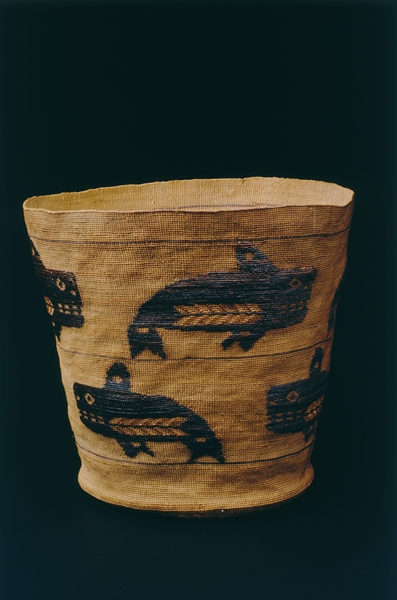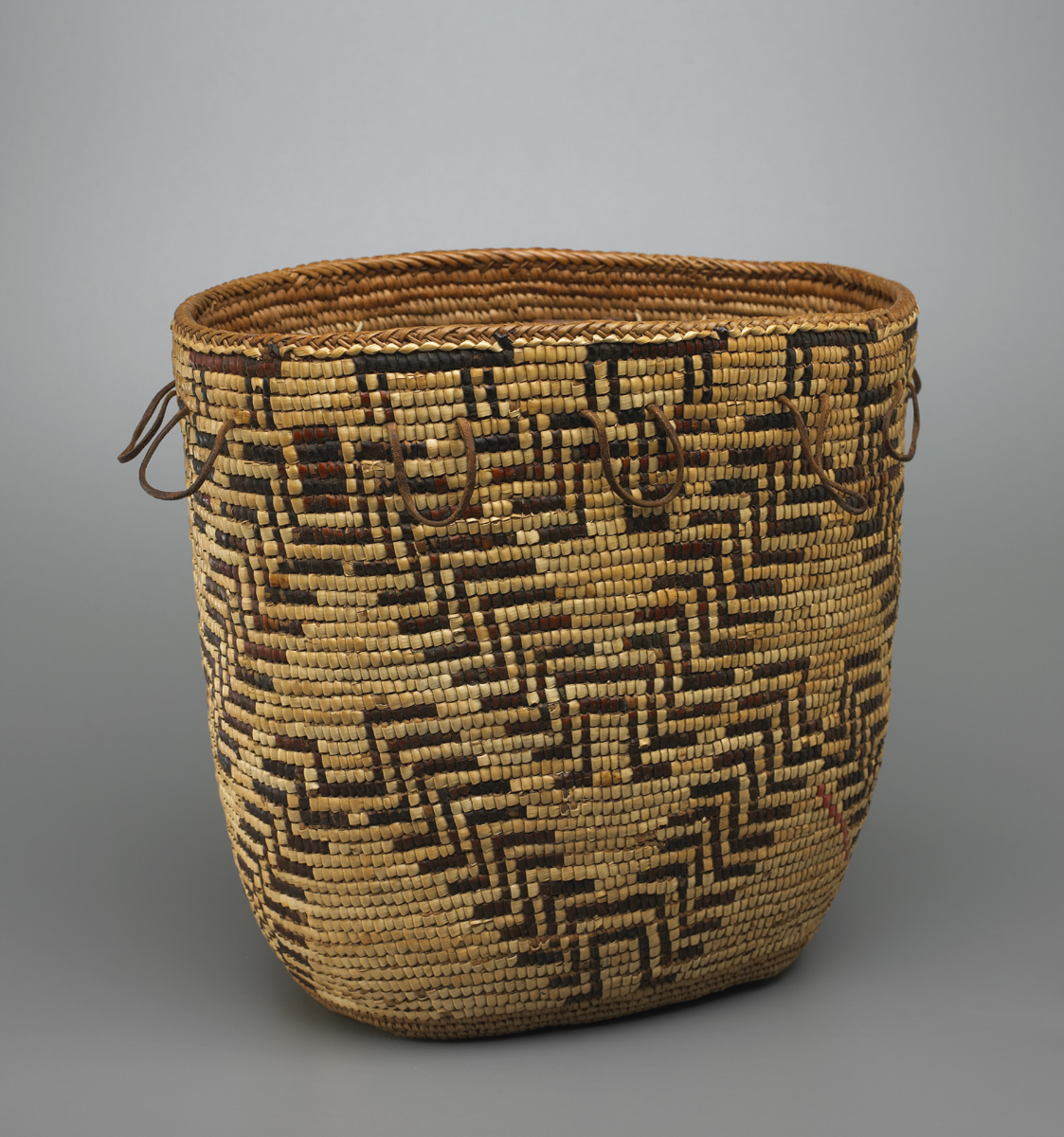My Five – An Intern’s Favorite Things
Katie Morris is a graduate intern at the Seattle Art Museum, working with the Curatorial Division this fall. This week, she gave a thoughtful and insightful tour of five of her favorite objects to SAM staff and interns. Here, she shares her thoughts with you.
-Sarah Berman, Curatorial Associate for Collections
Having been asked to choose my five favorite pieces of art on display at SAM I must apologize because I have come to the conclusion that I simply cannot achieve this goal. For me, it is impossible. Not only did I find that choosing five objects above all others on my preliminary “list of favorites” too difficult, in the process of attempting to fine-tune my selection I would inevitably find another intriguing or beautiful object that captured my eye with every walk through the gallery space. And don’t get me started on what a new day and different mood did to my selection.
So, with defeat not an option I tried to look at the task from a different angle, to give myself some boundaries and to try and anchor my selections. With this in mind a very large theme began to emerge across many of the objects at SAM – the theme of Ceremony.
In its most basic sense, ceremony is defined as a ritual observance and procedure performed at grand or formal occasions. In many regards, ceremony is apart of our daily lives.
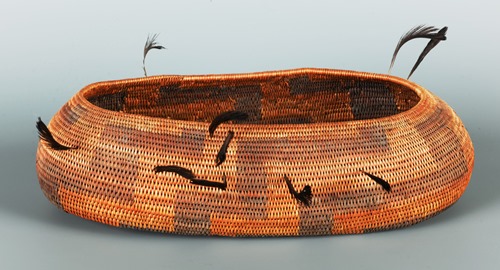
Canoe-shaped bowl with quail topknots, early 20th century, Native American, Californian, Pomo, willow, sedge root, bracken fern root, quail feathers, 1 3/4 × 6 1/4 × 2 1/4in., Gift of the Estate of Robert M. Shields, 2013.4.13. Currently on view in the Native American art galleries, Seattle Art Museum.
This canoe-shaped bowl with quail topknots is a quiet symbol of ceremony. For Native American Indians of the American West, basketry and weaving is considered a highly skilled art form passed down between generations. A woven object not only usually serves a direct and functional purpose, but it is also indicative of a broader system of cultural knowledge in its design, technique and the materials available locally for its creation.
Baskets such as this one were made as simple containers, but also as gifts during formal occasions. For example, traditional wedding ceremonies in certain regions often included the bride and groom gifting each other baskets full of objects signifying commitment; for women, bread and corn to symbolize the lifetime of support she will share with her new husband, for men, meat and skins for his bride to represent his promise to feed and clothe her. Baskets in other clans were used during birthing ceremonies, holding the baby’s umbilical cord along with other objects of meaning so that the ancestors will recognize them when they arrive in the spirit world.
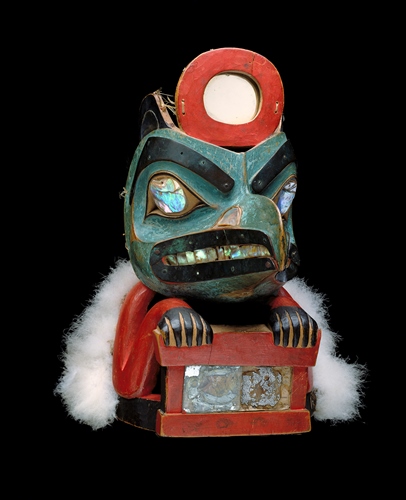
Lkaayaak yeil s’aaxw (Box of Daylight Raven Hat), ca. 1850, Native American, Tlingit, Taku, Gaanax’adi clan, maple, mirror, abalone shell, bird skin, paint, sea lion whiskers, copper, leather, Flicker feathers, 11 7/8 x 7 3/4 x 12 1/4in., Gift of John H. Hauberg, 91.1.124. Currently on view in the Native American art galleries, Seattle Art Museum.
This carving of maple, mirror, abalone shell, bird skin, sea lion whiskers, copper, leather and Flicker feathers is an elaborate example of Tlingit carved wood hats. These carvings, attached to larger headdresses, are among the most significant objects of Tlingit clans, kept safe by the clan leader or caretaker. They are shown or worn only on ceremonial occasions and their carving often captures distinct geographic features, animals or natural phenomena that form part of the clan’s legends to which it belongs.
This carved wood hat depicts Raven with human-like hands and fingers. Tlingit legend says that Raven was responsible for organizing the world to the form that we inhabit it today – this carving shows him releasing the sun, the red disk above his head, and the stars and moon which are in the box that he holds. It is unusual in its full sculptural form of Raven, who is frequently depicted in the face only.
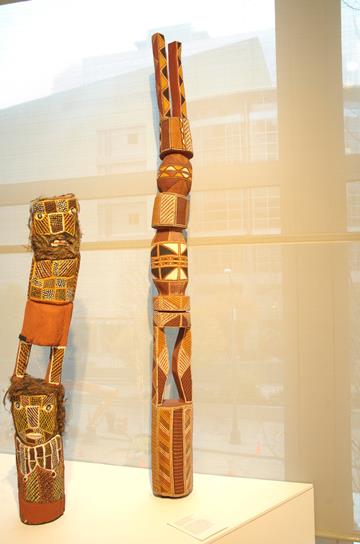
Pukamani pole, 1999, Leon Puruntatamari, Australian Aboriginal, Tiwi Islands, Melville Island, born 1949, natural pigments with fixative on ironwood, height 104 5/16in., Partial and promised gift of Margaret Levi and Robert Kaplan, in honor of the 75th Anniversary of the Seattle Art Museum, 2005.155, © Leon Puruntatamari. Currently on view in the Australian Aboriginal art gallery, Seattle Art Museum.
This ironwood Pukamani pole is another example of carving used in ceremony. For the Tiwi people of the Tiwi Islands, just off the coast of the Northern Territory in Australia, Pukamani is the ceremony surrounding death. It is performed over a series of rituals beginning with the burial of the body and culminating in the final ceremony where carved Pukamani poles are placed around the grave in a circular shape to contain and comfort the spirit of the deceased.
Between death and the final placement of burial poles around the grave sometimes more than a year will pass, but most often about six months, as the family of the deceased work to organize the people who will be involved in the ceremonial duties. It also takes a long time to carve and paint a Pukamani pole. The artists of Pukamani poles such as Leon Puruntatamari, who made this example, are paid for their artistic efforts as whilst it is a privilege to be commissioned to complete a burial pole, the deceased’s honor is attached with how his or her family arranges the Pukamani ceremonies and how generous they are with those participating.
At a Pukamani ceremony members of different Tiwi clans congregate to ensure the safe and happy journey of the deceased to the spirit world through dance and song. People will paint their bodies with designs not foremost to designate clan as is usually thought to be the case, but rather to disguise the body from the deceased who is considered to be in trickster mode until the completion of Pukamani rituals. Tiwi people will also wear feather armbands and headdresses in order to better disguise themselves.

Katie Morris, looking at paintings by Emily Kngwarreye, promised gifts of Margaret Levi and Robert Kaplan, all paintings © Emily Kngwarreye. Currently on view in the Australian Aboriginal art gallery, Seattle Art Museum.
Although there are thousands of miles between the Tiwi Islands and Emily Kngwarreye’s Country Alhalkere, in Australia’s Utopia region of the central Desert, the act of body painting during and for ceremony is of equal and sacred importance.
Emily Kngwarreye starting painting on canvas in 1989 and before her death in 1996 she completed close to 3000 works. Posthumously she has been celebrated as a great abstract painter, contributing to the same artistic dialogue as artists such as Jackson Pollock and Willem de Kooning. But Emily Kngwarreye never saw one of these iconic artist’s work, let alone studied them in a book. For Emily, her work considered and was about one subject only: her Country.
In Awelye (Ceremony), we are seeing the same lines on the canvas as they traditionally appear on the body during women’s ceremonies. With this in mind, the surface of the painting can be likened to a ceremonial ground in which Emily Kngwarreye reenacted the ceremony to which she was custodian. She was known to sing as she painted, using the canvas to remember and pay homage to her Country. With each brushstroke she connected herself to her ancestors and kin.
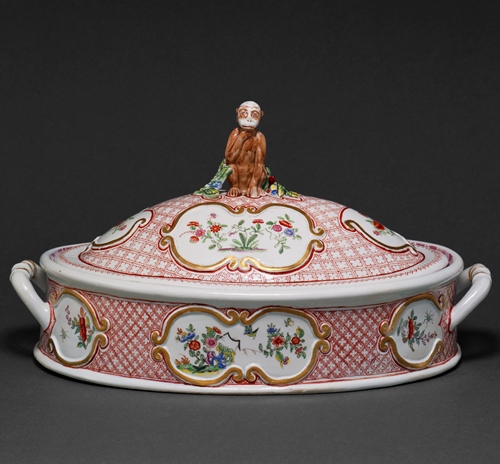
Tureen, ca. 1725-30, Austrian, Du Paquier manufactory, hard paste porcelain, 7 3/4 x 8 1/8 x 14in. overall, Gift of Martha and Henry Isaacson, 69.171. Currently on view in the Porcelain Room, Seattle Art Museum.
With family in mind, my final object of ceremony is of a vastly different tone to my four previous choices. It is in no way intended to trivialize the extreme significance of the four preceding examples of objects I have presented which are tied to ceremony, but rather to simply present another object from a new angle. Given the time of year and the busy Holiday season approaching, I cannot help but reflect on the ceremonies that I know I will be apart of in the last months of the year.
This hard paste porcelain tureen was produced in Vienna sometime between 1725 and 1730. The many treasures that made their way back to Europe as a result of increased trade in the eighteenth century influenced its design. You can see the lure of exotic and distant lands that came about with this travel is visible in the monkey and Japanese-inspired floral decoration.
When looking at this quirky object of domesticity I find myself wondering of the tables that this tureen has graced and the conversations it has overheard. Has it been apart of a wedding or a birthday celebration? Or perhaps a meal on a religious holiday? After all, what is the act of sitting around a dining table during the holidays or a special occasion with family and friends? Whether your holiday meals involve an elegant monkey tureen or paper plates and takeaway containers, I suggest that it is all ceremony.
-Katie Morris, Curatorial intern, 2014
